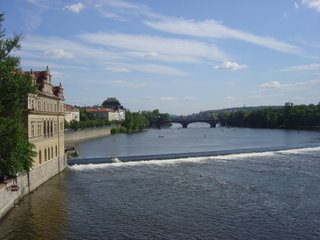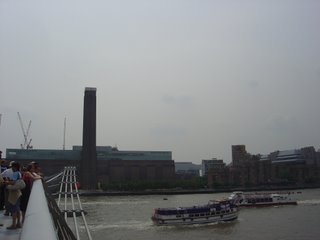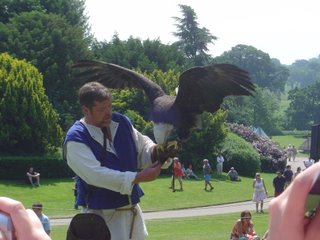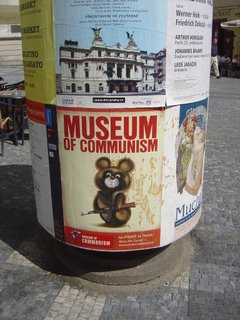
Chuck has had a visit to Prague in the works for some time -- since before Christmas -- and, since we had heard wonderful things about that city from everyone we know who has visited it, Kathi decided some time ago that this was one of those trips where she would accompany Chuck. Unfortunately, at the last minute, the plans had to be truncated so that Chuck could return to the office for a "can't-miss" event. Therefore the visit was quite short -- we went on Sunday morning, 11 June, and had to return on Tuesday morning, the 13th.
But our short time in Prague was enough to show us that all those great things we'd been told were true. It is a city filled with interesting things and places and is very, very beautiful. Our hotel was only a 5 or 6 minute walk from the main square, which we visited on Sunday -- going on later to the Charles Bridge over the Vltava River and to the "Lesser Town" on the other side. The incredible Prague Castle, the largest castle/palace in Europe, is on that side of the river, atop a hill that's a great aerobic workout! St. Vitus' cathedral, a great example of the European gothic cathedral, is actually located within the Castle.
Being a bit of a nut about architecture, Chuck was in his element for all of our time walking about this city of thousands of beautiful buildings from many different centuries. (Prague was fortunate enough to make it through World War II with relatively little damage.) Art Noveau buildings are in evidence everywhere, with their classical decorative motifs of heroic statues and the elaborate stonework on the second floor exterior, which is their trademark. And, of course, being the ancient city that it is, Prague also abounds in buildings from the medieval era and even a few from earlier periods. And, classic and neo-classic, baroque and rococo are all well-represented. Very narrow medieval streets, barely wide enough for a single car to pass, run right through the same neighborhoods with tree-lined, leafy boulevards.
For several centuries the Czech people (and Prague) were part of the Austro-Hungarian Empire, with its capital, of course, in Vienna. During this period many Czechs harbored a desire to have their own nations. The victorious Allies, at the end of World War I, d

ecided to combine the Czechs with the Slovenians in Czechoslovakia, with Prague now a capital city. After the fall of the Soviet Union, the Czechs and Slovenians each decided to establish their own independent nation -- and today's Czech Republic was one of them.
The Czechs have a long history of mechanical and technological competence and it is one of the most highly developed nations in Europe, industrially. The famous Skoda works, which now builds cars (and is owned by VW), was famous in the past for its armaments; and today the Czech Republic has a flourishing chemical industry. Of course, it has always been famous for the fine glasswork that is one of its biggest exports and Czech glass is a very popular tourist purchase.
Our visit included dinner on Sunday night in a rooftop cafe looking out over the main square. Our companions were Jim and Susan DeCorpo (Jim is the Chief Scientist in Chuck's office) and Martin Navratil (our host and the Chairman of a small Czech chemical company) and his wife Milada. They are part-time residents of North Carolina, when not in Prague -- and both their daughters have attended UNC at Chapel Hill. The food was great and the company fascinating.
On Monday, while Jim and Chuck were visiting Martin's company to learn about some new technology, Kathi and Susan did some exploring together, including the beautiful gardens of the Wallenstein Palace. Susan had to depart on Monday to return to London where she was expecting the arrival of houseguests. Monday evening, Kathi, Chuck and Jim dined together at an outdoor cafe just off the square.
It was an interesting time to be at the square -- it was the night the USA played the Czech Republic in the World Cup football (soccer) matches and the game was being televised on two enormous screens to a huge, densely packed crowd of (mostly) Czech fans on the square. Other than the fact that the USA lost 3-0, it was a pleasant experience -- the Czech fans were unfailingly pleasant and they, and the hundreds of Americans present (many on both sides wearing very prominent markings of their soccer loyalties) behaved in a friendly, very civilized way. If the US had won the match, it would have been a perfect evening.
Reluctantly, on Tuesday morning, the three of us returned to London on the same flight so that Jim and Chuck could be at the office by noon for the important event they had to be present for.
We join the hundreds and thousands of others who have sung the praises of Prague and recommend it very highly as a destination to visit. We intend to return for a longer stay at the first opportunity.
Visit
http://chuck.smugmug.com/gallery/1563021 for our gallery of Prague photographs.
 OK, let's admit this right at the outset. Some of us don't care for much of what is called modern art. Go ahead, put us in the Philistine category! We've tried. We've read the art critics. We've looked at the coffee table books. And now we've attended the famous Tate Modern Museum on the banks of the Thames. With few exceptions we don't get it. (If you're a fan, well it's just one of those taste things.)
OK, let's admit this right at the outset. Some of us don't care for much of what is called modern art. Go ahead, put us in the Philistine category! We've tried. We've read the art critics. We've looked at the coffee table books. And now we've attended the famous Tate Modern Museum on the banks of the Thames. With few exceptions we don't get it. (If you're a fan, well it's just one of those taste things.) is quite spectacular -- the building was built as a large electric power plant that was taken out of service some time ago and fully refurbished. The exhibits actually only consume a small fraction of the available space; there are three shops and two restaurants. It's nicely done. Then of course there's the art!
is quite spectacular -- the building was built as a large electric power plant that was taken out of service some time ago and fully refurbished. The exhibits actually only consume a small fraction of the available space; there are three shops and two restaurants. It's nicely done. Then of course there's the art! ed from our grandson Tyler. We think it's far better than much of what we saw in the Tate Modern. Of course, we might be considered a bit biased. (Did YOU
ed from our grandson Tyler. We think it's far better than much of what we saw in the Tate Modern. Of course, we might be considered a bit biased. (Did YOU  get your "e" right all the time when you were 5?)
get your "e" right all the time when you were 5?)






